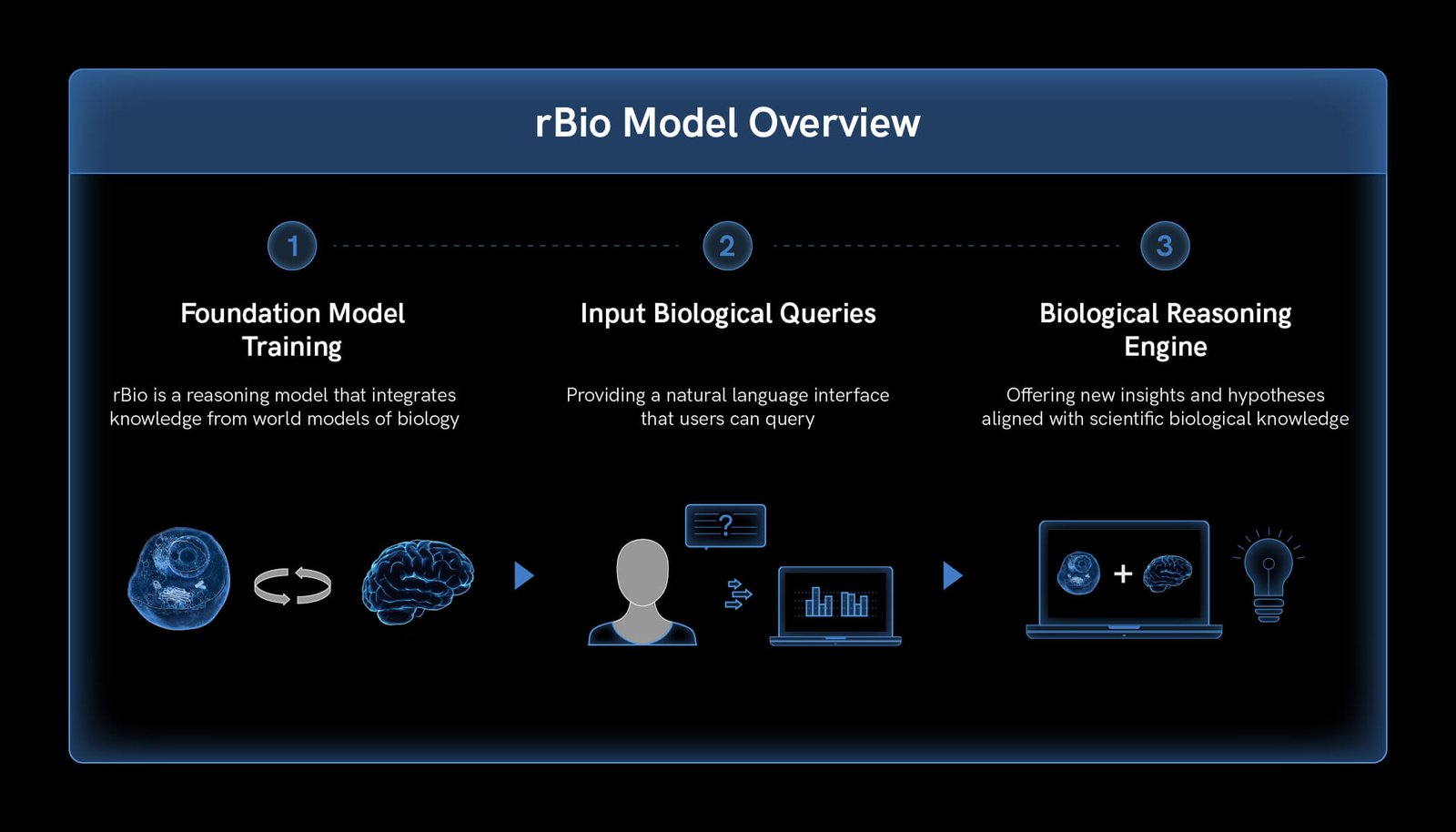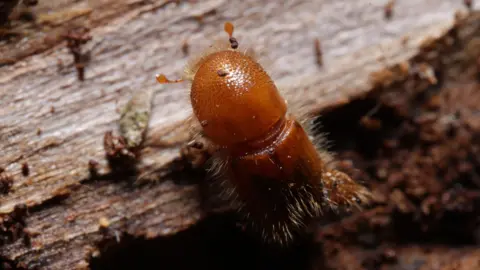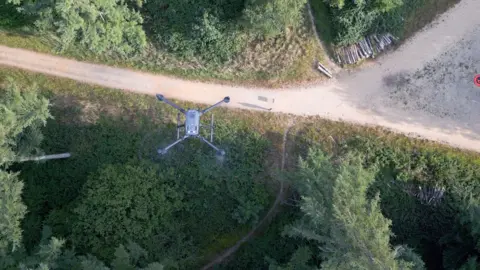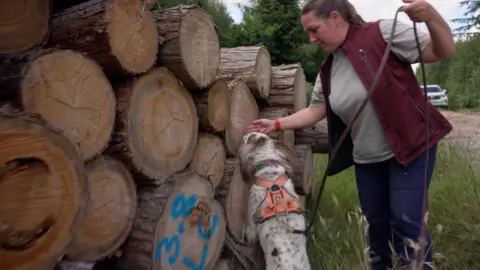AI Research
Reasoning Model Trained on Virtual Cell Simulations

In recent years, large language models (LLMs), such as OpenAI’s ChatGPT, have taken the world by storm, offering user-friendly, conversational access to virtually all the information found on the internet. LLMs have proved to be great time-savers for scientists, because they can rapidly answer researchers’ questions and summarize scientific research. But as a tool for doing serious science, LLMs have their limits: ask them an open-ended question involving complex raw data and they quickly hit a wall.
Enter “reasoning models,” a recently developed subcategory of language models that incorporate logic and problem-solving. Though generally not as fast as standard LLMs, reasoning models like OpenAI’s o-series are superior at tasks where context and deduction are especially important.
A key focus for the Chan Zuckerberg Initiative is building AI-based virtual cell models, digital representations of cells that can be used in computer-simulated experiments that predict how actual cells will behave in laboratory experiments. Such models promise to greatly accelerate the pace of research, yet they are complex and often require many researchers to have special expertise. In addition, there are sometimes many different virtual cell models related to a particular task without an established way to coherently incorporate them into a single workflow. Most reasoning models also require vast amounts of experimental data to be trained, but oftentimes, there are models of datasets available without the actual datasets in the public domain.
To bridge this usability gap, CZI today announces rBio, the first reasoning model trained on virtual cell simulations from one or many virtual cell models. rBio distills information extracted from virtual cell models into a consistent model of natural language during training to allow users to easily apply sophisticated step-by-step reasoning to complex biological problems. This effectively turns virtual cell models into biology teachers for reasoning models, sidestepping the need for experimental data as the only teacher, and resulting in more capable reasoning LLMs for biology. Combining the power of one or many virtual cell models with the chat-style interface of LLMs could empower many more scientists to study biological questions based on rich foundation models of biology while remaining within a familiar interface.
An LLM That Taps the Power of Virtual Cells
When presented with completely new data and hypotheses, rBio saves scientists time by predicting research outcomes before they commit time and resources to test and discard multiple hypotheses in costly laboratory research.
While rBio has the potential to learn from many approaches to cell biology, the model has first been trained on perturbation models and gene co-expression patterns and gene regulatory pathways information extracted from TranscriptFormer — one of CZI’s virtual cell models. This versatile model is able to classify the variety of cell types and states across different species and stages of development. Scientists can ask rBio questions such as, “Would suppressing the actions of gene A result in an increase in activity of gene B?” In response, the model provides information about the resulting changes to cells, such as a shift from a healthy to a diseased state.
Answers to these questions can shape our understanding of the gene interactions contributing to neurodegenerative diseases like Alzheimer’s. Such knowledge could lead to earlier intervention, perhaps halting these diseases altogether someday.
rBio is another important step in CZI’s vision to build AI systems that can think like scientists — producing new knowledge by learning from virtual cell models and data. In building rBio, CZI has also constructed a broader framework for funneling the vast knowledge of virtual cell models, which will help build a range of widely accessible AI tools for biology in the coming years.
What’s Inside the rBio Box
While designing rBio, the research and engineering teams, led by CZI Senior Director of AI Theofanis Karaletsos and Senior Research Scientist Ana-Maria Istrate, overcame a fundamental challenge to teaching biology to LLMs. Language models are designed to learn from questions with unambiguous outcomes, such as “2 + 2 = ?” or whether water consists of hydrogen and oxygen. But biological questions must incorporate varying levels of uncertainty, such as whether a new drug is likely to cure a specific form of cancer.
With TranscriptFormer as a foundation, CZI engineers applied new methods to how LLMs are trained. Using an off-the-shelf language model as a scaffold, the team trained rBio with reinforcement learning, a common technique in which the model is rewarded for correct answers. But instead of asking a series of yes/no questions, the researchers tuned the rewards in proportion to the likelihood that the model’s answers were correct. This novel approach means that rBio learned to propose hypotheses that align with biological reality — improving accuracy, coherence and scientific value.
While TranscriptFormer takes its instructions and returns results as complex data, rBio allows users to interact in plain language. For example, during training, rBio was asked questions with the following structure: Are gene A and gene B likely to be co-expressed? Give a binary yes/no answer only. As a reasoning model, rBio can now answer these same questions worded differently.
But training an LLM using “soft” outcomes runs the risk of producing an inaccurate model. To ensure that rBio was not being misled, the team compared the model’s performance with that of multiple baseline LLMs. Across a variety of cell-labeling and perturbation prediction challenges, rBio outperformed the baseline models, showing that virtual cell models can be used to train a reliable LLM to reason about biology. Specifically, this first version of rBio outperforms previously published models on the PerturbQA benchmark like SUMMER (ICLR 2025), baseline LLMs like QWEN2.5, and matches a strongly performant rBio ablation directly trained on experimental data when using chain-of-thought. In other results, rBio improved understanding of perturbation tasks — activating or deactivating particular genes — zero-shot by learning general biology like gene co-expression patterns from TranscriptFormer, a model and task unrelated to perturbation. This shows promise for further inquiry about transferable knowledge from virtual cell models.
Meet more CZI models: Teaching AI To Think Like a Cell
rBio in Action
Now available on CZI’s virtual cell platform, rBio can help accelerate the work of scientists studying gene perturbation in the laboratory. Machine learning practitioners can also use the rBio framework to train their own LLMs, or use rBio itself to benchmark their models.
rBio’s expertise is currently limited to gene perturbation, but every domain of cell biology covered by TranscriptFormer could be taught to rBio. In the future, the family of virtual cell models on the virtual cell platform could all be used to train similar reasoning models, or combined into comprehensive language models that understand cells from the smallest molecule to the largest system.
While rBio is ready for research, the model’s engineering team is continuing to improve the user experience, because the flexible problem-solving that makes reasoning models conversational also poses a number of challenges. One of these is ensuring the model has appropriate guardrails to keep rBio from providing answers to questions outside its expertise. These safety measures are a common step in the responsible development of all LLMs, such as when models decline to provide medical advice to users.
AI is already accelerating the pace of biological research. Virtual cell models are saving researchers from fruitless laboratory experiments, while LLMs provide a convenient way to build knowledge conversationally. rBio combines these strengths, demonstrating a framework for harnessing AI to answer biology’s toughest questions without the need for domain expertise. As CZI’s family of virtual cell models grows, reasoning models like rBio will help scientists as they study, develop treatments, and ultimately prevent disease.
Researchers can access rBio on the virtual cell platform, including a quick start; tutorial; the codebase on GitHub; and the preprint on bioRxiv.
AI Research
Tories pledge to get ‘all our oil and gas out of the North Sea’

Conservative leader Kemi Badenoch has said her party will remove all net zero requirements on oil and gas companies drilling in the North Sea if elected.
Badenoch is to formally announce the plan to focus solely on “maximising extraction” and to get “all our oil and gas out of the North Sea” in a speech in Aberdeen on Tuesday.
Reform UK has said it wants more fossil fuels extracted from the North Sea.
The Labour government has committed to banning new exploration licences. A spokesperson said a “fair and orderly transition” away from oil and gas would “drive growth”.
Exploring new fields would “not take a penny off bills” or improve energy security and would “only accelerate the worsening climate crisis”, the government spokesperson warned.
Badenoch signalled a significant change in Conservative climate policy when she announced earlier this year that reaching net zero would be “impossible” by 2050.
Successive UK governments have pledged to reach the target by 2050 and it was written into law by Theresa May in 2019. It means the UK must cut carbon emissions until it removes as much as it produces, in line with the 2015 Paris Climate Agreement.
Now Badenoch has said that requirements to work towards net zero are a burden on oil and gas producers in the North Sea which are damaging the economy and which she would remove.
The Tory leader said a Conservative government would scrap the need to reduce emissions or to work on technologies such as carbon storage.
Badenoch said it was “absurd” the UK was leaving “vital resources untapped” while “neighbours like Norway extracted them from the same sea bed”.
In 2023, then Prime Minister Rishi Sunak granted 100 new licences to drill in the North Sea which he said at the time was “entirely consistent” with net zero commitments.
Reform UK has said it will abolish the push for net zero if elected.
The current government said it had made the “biggest ever investment in offshore wind and three first of a kind carbon capture and storage clusters”.
Carbon capture and storage facilities aim to prevent carbon dioxide (CO2) produced from industrial processes and power stations from being released into the atmosphere.
Most of the CO2 produced is captured, transported and then stored deep underground.
It is seen by the likes of the International Energy Agency and the Climate Change Committee as a key element in meeting targets to cut the greenhouse gases driving dangerous climate change.
AI Research
Dogs and drones join forest battle against eight-toothed beetle

Esme Stallard and Justin RowlattClimate and science team
 Sean Gallup/Getty Images
Sean Gallup/Getty ImagesIt is smaller than your fingernail, but this hairy beetle is one of the biggest single threats to the UK’s forests.
The bark beetle has been the scourge of Europe, killing millions of spruce trees, yet the government thought it could halt its spread to the UK by checking imported wood products at ports.
But this was not their entry route of choice – they were being carried on winds straight over the English Channel.
Now, UK government scientists have been fighting back, with an unusual arsenal including sniffer dogs, drones and nuclear waste models.
They claim the UK has eradicated the beetle from at risk areas in the east and south east. But climate change could make the job even harder in the future.
The spruce bark beetle, or Ips typographus, has been munching its way through the conifer trees of Europe for decades, leaving behind a trail of destruction.
The beetles rear and feed their young under the bark of spruce trees in complex webs of interweaving tunnels called galleries.
When trees are infested with a few thousand beetles they can cope, using resin to flush the beetles out.
But for a stressed tree its natural defences are reduced and the beetles start to multiply.
“Their populations can build to a point where they can overcome the tree defences – there are millions, billions of beetles,” explained Dr Max Blake, head of tree health at the UK government-funded Forestry Research.
“There are so many the tree cannot deal with them, particularly when it is dry, they don’t have the resin pressure to flush the galleries.”
Since the beetle took hold in Norway over a decade ago it has been able to wipe out 100 million cubic metres of spruce, according to Rothamsted Research.
‘Public enemy number one’
As Sitka spruce is the main tree used for timber in the UK, Dr Blake and his colleagues watched developments on continental Europe with some serious concern.
“We have 725,000 hectares of spruce alone, if this beetle was allowed to get hold of that, the destructive potential means a vast amount of that is at risk,” said Andrea Deol at Forestry Research. “We valued it – and it’s a partial valuation at £2.9bn per year in Great Britain.”
There are more than 1,400 pests and diseases on the government’s plant health risk register, but Ips has been labelled “public enemy number one”.
The number of those diseases has been accelerating, according to Nick Phillips at charity The Woodland Trust.
“Predominantly, the reason for that is global trade, we’re importing wood products, trees for planting, which does sometimes bring ‘hitchhikers’ in terms of pests and disease,” he said.
Forestry Research had been working with border control for years to check such products for Ips, but in 2018 made a shocking discovery in a wood in Kent.
“We found a breeding population that had been there for a few years,” explained Ms Deol.
“Later we started to pick up larger volumes of beetles in [our] traps which seemed to suggest they were arriving by other means. All of the research we have done now has indicated they are being blown over from the continent on the wind,” she added.
 Daegan Inward/Forestry Research
Daegan Inward/Forestry ResearchThe team knew they had to act quickly and has been deploying a mixture of techniques that wouldn’t look out of place in a military operation.
Drones are sent up to survey hundreds of hectares of forest, looking for signs of infestation from the sky – as the beetle takes hold, the upper canopy of the tree cannot be fed nutrients and water, and begins to die off.
But next is the painstaking work of entomologists going on foot to inspect the trees themselves.
“They are looking for a needle in a haystack, sometimes looking for single beetles – to get hold of the pioneer species before they are allowed to establish,” Andrea Deol said.
In a single year her team have inspected 4,500 hectares of spruce on the public estate – just shy of 7,000 football pitches.
Such physically-demanding work is difficult to sustain and the team has been looking for some assistance from the natural and tech world alike.
 Tony Jolliffe/BBC
Tony Jolliffe/BBCWhen the pioneer Spruce bark beetles find a suitable host tree they release pheromones – chemical signals to attract fellow beetles and establish a colony.
But it is this strong smell, as well as the smell associated with their insect poo – frass – that makes them ideal to be found by sniffer dogs.
Early trials so far have been successful. The dogs are particularly useful for inspecting large timber stacks which can be difficult to inspect visually.
The team is also deploying cameras on their bug traps, which are now able to scan daily for the beetles and identify them in real time.
“We have [created] our own algorithm to identify the insects. We have taken about 20,000 images of Ips, other beetles and debris, which have been formally identified by entomologists, and fed it into the model,” said Dr Blake.
Some of the traps can be in difficult to access areas and previously had only been checked every week by entomologists working on the ground.
The result of this work means that the UK has been confirmed as the first country to have eradicated Ips Typographus in its controlled areas, deemed to be at risk from infestation, and which covers the south east and east England.
“What we are doing is having a positive impact and it is vital that we continue to maintain that effort, if we let our guard down we know we have got those incursion risks year on year,” said Ms Deol.
 Tony Jolliffe/BBC
Tony Jolliffe/BBCAnd those risks are rising. Europe has seen populations of Ips increase as they take advantage of trees stressed by the changing climate.
Europe is experiencing more extreme rainfall in winter and milder temperatures meaning there is less freezing, leaving the trees in waterlogged conditions.
This coupled with drier summers leaves them stressed and susceptible to falling in stormy weather, and this is when Ips can take hold.
With larger populations in Europe the risk of Ips colonies being carried to the UK goes up.
The team at Forestry Research has been working hard to accurately predict when these incursions may occur.
“We have been doing modelling with colleagues at the University of Cambridge and the Met Office which have adapted a nuclear atmospheric dispersion model to Ips,” explained Dr Blake. “So, [the model] was originally used to look at nuclear fallout and where the winds take it, instead we are using the model to look at how far Ips goes.”
Nick Phillips at The Woodland Trust is strongly supportive of the government’s work but worries about the loss of ancient woodland – the oldest and most biologically-rich areas of forest.
Commercial spruce have long been planted next to such woods, and every time a tree hosting spruce beetle is found, it and neighbouring, sometimes ancient trees, have to be removed.
“We really want the government to maintain as much of the trees as they can, particularly the ones that aren’t affected, and then also when the trees are removed, supporting landowners to take steps to restore what’s there,” he said. “So that they’re given grants, for example, to be able to recover the woodland sites.”
The government has increased funding for woodlands in recent years but this has been focused on planting new trees.
“If we only have funding and support for the first few years of a tree’s life, but not for those woodlands that are 100 or century years old, then we’re not going to be able to deliver nature recovery and capture carbon,” he said.
Additional reporting Miho Tanaka

AI Research
AI replaces excuses for innovation, not jobs
AI isn’t here to replace jobs, it’s here to eliminate outdated practices and empower entrepreneurs to innovate faster and smarter than ever before.

-
Tools & Platforms3 weeks ago
Building Trust in Military AI Starts with Opening the Black Box – War on the Rocks
-

 Ethics & Policy1 month ago
Ethics & Policy1 month agoSDAIA Supports Saudi Arabia’s Leadership in Shaping Global AI Ethics, Policy, and Research – وكالة الأنباء السعودية
-

 Events & Conferences3 months ago
Events & Conferences3 months agoJourney to 1000 models: Scaling Instagram’s recommendation system
-

 Jobs & Careers2 months ago
Jobs & Careers2 months agoMumbai-based Perplexity Alternative Has 60k+ Users Without Funding
-

 Business1 day ago
Business1 day agoThe Guardian view on Trump and the Fed: independence is no substitute for accountability | Editorial
-

 Funding & Business2 months ago
Funding & Business2 months agoKayak and Expedia race to build AI travel agents that turn social posts into itineraries
-

 Education2 months ago
Education2 months agoVEX Robotics launches AI-powered classroom robotics system
-

 Podcasts & Talks2 months ago
Podcasts & Talks2 months agoHappy 4th of July! 🎆 Made with Veo 3 in Gemini
-

 Podcasts & Talks2 months ago
Podcasts & Talks2 months agoOpenAI 🤝 @teamganassi
-

 Jobs & Careers2 months ago
Jobs & Careers2 months agoAstrophel Aerospace Raises ₹6.84 Crore to Build Reusable Launch Vehicle


